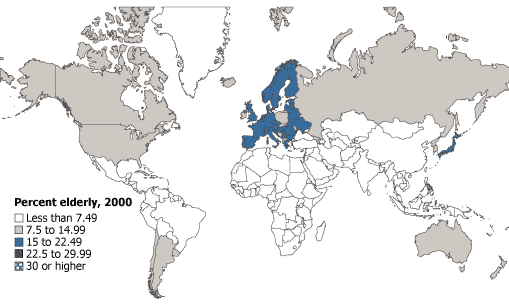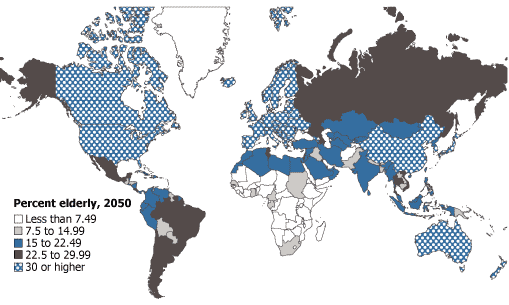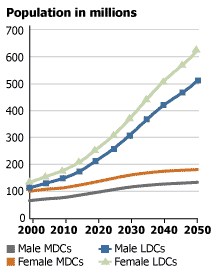
A Critical Window for Policymaking on Population Aging in Developing Countries
Date
January 9, 2006
Author
Focus Area
(January 2006) The world’s elderly population is quickly growing, both in its absolute numbers and in its percentage relative to the younger population—the latter trend known as population aging.
And populations are aging even faster in the developing world, as fertility rates there have declined more rapidly and more recently than in the developed world.1 Asia and Latin America and the Caribbean are the world’s fastest aging regions, with the percent of elderly in both regions projected to double between 2000 and 2030 (see Figure 1).2 Even sub-Saharan Africa, which has the smallest proportion of elderly and which is aging slower than any other region, is projected to see the absolute size of its older population grow by 2.3 times between 2000 and 2030.3
Figure 1
Percentage of Elderly (Ages 65 and Over) by Country, 2000 and 2050
2000

2050

Source: United Nations Population Division, World Population Prospects: The 2004 Revision (New York: United Nations, 2005).
But less developed countries—which have much lower levels of economic development and access to adequate health care than more developed countries—will be hard-pressed to meet the challenges of more elderly people, especially as traditional family support systems for the elderly are breaking down. Policymakers in the developing world need to invest soon in formal systems of old-age support to be able to meet these challenges in the coming decades.
Challenges of Population Aging
Although population aging presents major challenges for even the most developed countries, developing countries face particular issues in constructing policies that address increasing elderly populations.
Strain on informal support systems. Elderly in developing countries have relied heavily on their family for personal care and material support. Today, however, such support is under pressure from trends that include falling fertility rates (which mean fewer children as caregivers); changing cultural norms; increased longevity of the elderly; and the migration of rural young people to cities and away from elderly relatives.
Several trends might also soon have impact on informal support systems. First, the proportion of the elderly who are divorced or never married will likely increase, reflecting the marriage patterns of today’s younger cohorts. Second, the percentages of the elderly who live alone, only with their spouse (without any adult children), or in institutional settings will likely increase in developing countries because of declining fertility, changing norms of familial support, improved joint survival of couples, and a potentially growing acceptance and availability of institutional care for the elderly. Third, rapid urbanization and growing out-migration of young adults to urban areas may mean that their parents will age in rural areas without the direct support of the children and face difficult living conditions without access to various amenities.4
Pressure on health care systems. The health care systems of many developing countries are still focused on childhood and infectious diseases as well as reproductive-health services. But population aging leads to increasing demand for care that addresses chronic health conditions. Per capita health expenditures also tend to be much higher for elderly adults than they are for younger adults.5 The growing size of elderly populations—combined with these populations’ disproportionately large consumption of health care per capita—will place increasing pressure on developing-country health care systems.
Shrinking productivity and increasing demand for pensions. Growth in elderly populations may pressure developing economies by increasing demand for pension payments and reducing economic productivity of work forces. Today’s relatively high level of labor force participation among older adults in developing countries reflects the lack of comprehensive old-age pension systems in these countries. Labor force participation rates for the elderly are projected to decline as economies expand and societies become wealthier.6
Figure 2
Population Ages 65 and Over in More Developed and Less Developed Countries, 2000-2050

Source: United Nations Population Division, World Population Prospects: The 2004 Revision (New York: United Nations, 2005).
Increasingly feminized older populations. Women generally make up the majority of elderly populations around the world, and the female advantage in life expectancy will probably widen further in the developing world as gender gaps in education and economic opportunities narrow (see Figure 2).7
Still, elderly women are generally more likely to be disabled, widowed, living alone, and to have fewer financial resources compared with elderly men at any given age.8 These factors must be taken into account in policies on the elderly, especially because women will make up an increasingly greater proportion of the elderly populations in developing countries.
Immediate Investment Needed in Systems of Old-Age Support
Policymakers must realize that many less developed countries currently have or will have a demographic window of opportunity over the next generation—an optimal time for investing in formal systems of old-age support. This window has been opened by falling fertility rates, which mean that the number of working-age adults in the developing world will continue over the next few decades to grow faster than the number of children and elderly.
To offset the impact of the demographic shift and other changes on the traditional system, policymakers must invest in the systems that would encourage and facilitate the elderly to work longer, save more, and rely on public pension and health care programs to meet their needs fully.9 Below are some policy measures that could help less developed countries to deal with population aging.10
Facilitate family provision of support. Programs to assist families in caring for the elderly include providing tax incentives for elder care and increasing day care and home nursing services.11 Creating public housing options for multigenerational living also encourages such living arrangements and might facilitate family care for the elderly.12
Increase employment opportunities for the elderly. Greater workforce retention levels would help elderly individuals save more for retirement; they would also bolster the fiscal viability of public pension and health care programs. Work disincentives and labor market impediments to the elderly (such as low mandatory retirement ages) should be eliminated. Increasing both flexible and part-time employment options as well as expanding educational programs for older workers are also essential. Finally, policymakers should encourage high rates of personal savings by managing inflation to secure the value of savings over the long-term.
Establish or expand public pension systems. Most developing countries have pension coverage that is restricted to small segments of the workforce, such as those working for government or large companies. Public pension programs, most of which also cover some disability insurance, provide an economic safety net and also allow risk pooling to mitigate the cost of becoming disabled, making poor investments, and outliving one’s savings.
However, providing wide coverage in developing countries requires political stability and may be administratively challenging, particularly in places with high proportions of agricultural, self-employed, and informal-sector workers.13 These programs also must be designed with enough capacity to incorporate the expanding ratio of elderly to working-age populations.
Prepare health care systems. As in the case of pension coverage, insurance programs for the elderly in most developing countries cover only a small minority of that population. Without universal access to even basic health care in many developing countries, securing the care to address chronic conditions for the elderly is often lower priority.
Finding Workable Policies on Aging
Developing or expanding health insurance programs for the elderly population, improving the capacity of health care systems to treat chronic conditions, and achieving these without forgoing vital services for other age groups—are major policy questions facing rapidly aging countries. (The issues raised in this article will be followed by discussions in two Web-exclusive articles over the next two months on aging and health care—one analyzing the preparedness of health care systems to handle population aging, and the next focusing on population aging in China.)
While developing countries can learn from the policy successes and failures of developed countries, adopting these policies in a short time frame and at much lower levels of economic development has never been attempted. Addressing the health care and economic needs of increasing numbers of elderly will also require balancing these needs with those of other populations as well as summoning the political will to support often very expensive programs. But the opportunity for such investments will be available only for a few decades, and the cost of squandering this opportunity will be high.
Toshiko Kaneda is policy analyst at the Population Reference Bureau.
References
- See more detailed discussions on the worldwide trends in population aging in Kevin Kinsella et al., An Aging World: 2001 (Washington, DC: Government Printing Office, 2001).
- United Nations Population Division, World Population Prospects: The 2004 Revision (New York: United Nations, 2005).
- United Nations Population Division, World Population Prospects: The 2004 Revision.
- Kevin Kinsella et al., An Aging World: 2001.
- Organization for Economic Co-operation and Development (OECD), Aging in OECD Countries: A Critical Policy Challenge, OECD Social Policy Studies 20 (Paris: OECD, 1997).
- Kevin Kinsella et al., An Aging World: 2001.
- Xian Liu et al., “The Effect of Education on Mortality Among Older Taiwanese and its Pathways,” Journal of Gerontology: Social Sciences 53B, no. 2 (1998): S71-S82.
- Kevin Kinsella et al., “Global Aging: The Challenge of Success,” Population Bulletin 60, no. 1 (2005).
- Sidney B. Westley et al., “Asia’s Aging Population,” in The Future of Population in Asia, ed. East-West Center Research Program, Population and Health Studies (Honolulu: East-West Center, 2002).
- See more detailed discussions on the policy options discussed below in Sidney B. Westley et al., “Asia’s Aging Population.”
- Bhakta B. Gubhaju et al., “Below-replacement Fertility in East and Southeast Asia: Consequences and Policy Responses,” Journal of Population Research 20, no. 1 (2003): 1-18.
- The World Bank, Averting the Old Age Crisis (Washington, DC: World Bank, 1994).
- Olivia S. Mitchell et al., “Designing Pension Systems for Developing Countries,” Pension Research Council Working Paper Series 1995-14 (1995).
